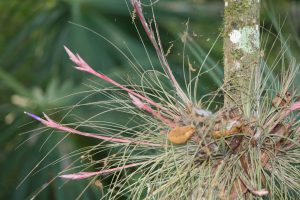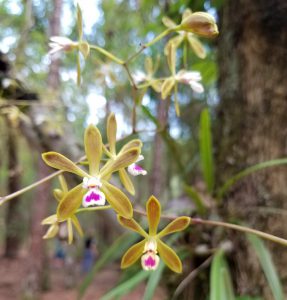Many of Florida’s native trees are decorated with a lot of “hitchhiking” plants. With the exception of mistletoe, these plants are not parasites, nor do they do any harm to the trees whatsoever. They are just seeking a spot in the sun; to grow and reproduce. These are a specialized group of plants known collectively as epiphytes.
What is an epiphyte?
The word comes from epi- which means “upon” and –phyto which refers to plants. So, literally, upon plants! From algae to ferns to flowering plants, this adaptation to life on the branches of trees provides a space in the sun without having to grow very tall.

In Pinellas County, the majority of native plants growing as epiphytes are in the bromeliad Family, Bromeliaceae, and in one Genus, Tillandsia. We also have three native epiphytic ferns, and a couple of species of epiphytic orchids. These plants have evolved an epiphytic growth habit. It may not be unusual to see a seedling of a non-epiphytic plant growing in the organic matter that has collected in the crotch of a tree, those would be considered incidental epiphytes.
Epiphyte Adaptations
An epiphytic growth habit comes with challenges. In return for getting a place in the sun, epiphytes’ roots have adapted to anchor the plant to the tree; losing the ability to draw water up from the soil and into the plants’ tissues. Bromeliads can store water in their leaf bases, absorbing water like a sponge via a covering of tiny scales, and many have very tough leaves that can avoid drying out. One of our native ferns, the Resurrection fern Pleopeltis michauxiana can almost completely dry out before re-absorbing rainfall and “resurrecting.” Epiphytic orchids have a modified root system that is covered in a velvety “velum” that is absorptive. Orchids can also photosynthesize via chlorophyll in their roots.
Spanish Moss

Perhaps our most abundant and certainly the most recognizable is the plant called “Spanish Moss.” It is neither Spanish nor is it a moss, but a native flowering bromeliad. This plant has an extremely reduced structure; producing leaves and flowers, but no roots or stems. As previously mentioned this plant is not parasitic; it derives no sustenance from the tree or structure it grows upon. In some cases if a tree is under stress and begins to decline, Spanish moss may appear to “smother” the tree, “killing” it. It is not the epiphyte that is the problem, and another issue is causing the tree to lose vigor.
Air Plants

Other native bromeliads include the “air plants” which can be found in treetops throughout the county. Unfortunately many are under attack from an introduced weevil, the Mexican bromeliad weevil. This insect lays its eggs in the “heart” of the plants and the larvae devour them from the inside out. This is fatal to the plants, and many natural populations of native bromeliads have been devastated. Research is underway to find a natural predator for this weevil.
Epiphytic Orchids
Of the 19 species of Orchids found in Pinellas, only two are epiphytic: the Butterfly Orchid, Encyclia tampensis, and the Needleroot Airplant Orchid, Dendrophylax porrectus.
Butterfly Orchid

The Butterfly Orchid regularly flowers here in Pinellas each June. This species is found most often on tree branches that overhang seasonally wet areas. These areas include cypress domes and flooded forests. Orchids do not have root hairs like most other land plants have; instead their roots are covered in a velvety tissue called vellum. This acts more like a sponge, mopping up and storing rainwater as well as moisture from humidity and evaporate.
Needleroot Airplant Orchid
The Needleroot Airplant orchid is leafless. Like many other epiphytic orchids worldwide, the roots contain photosynthetic tissues that can help facilitate sugar production. This orchid depends on its roots alone to provide for its needs. The narrow whitish roots with bright green growing tips form small (10cm, 4”) spiderlike encrustations on smooth-barked trees. The flowers are vanishingly small, likely moth pollinated. The fruit is the size of a large acorn held on wiry stem. Like all orchids, the fruit is a dry dehiscent capsule that splits upon maturity to release the dust-like seeds. Until recently this species was in a different Genus: Harrisella. DNA work has revealed that it is so closely related to the famous “Ghost Orchid” Dendrophylax lendinii that it belongs in that Genus.
Happy Learning!
This blog post was written by James Stevenson, Extension Specialist with UF/IFAS Extension Pinellas County, and reviewed by Lara Milligan, Natural Resources Agent.
 0
0
